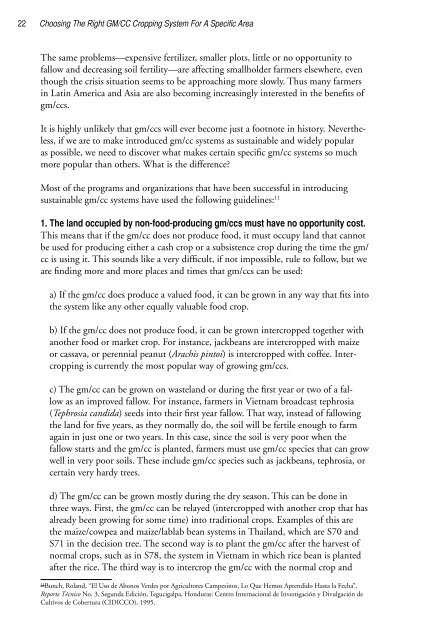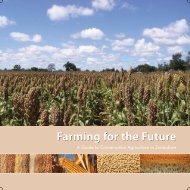Restoring the Soil - Canadian Foodgrains Bank
Restoring the Soil - Canadian Foodgrains Bank
Restoring the Soil - Canadian Foodgrains Bank
You also want an ePaper? Increase the reach of your titles
YUMPU automatically turns print PDFs into web optimized ePapers that Google loves.
22Choosing The Right GM/CC Cropping System For A Specific AreaThe same problems—expensive fertilizer, smaller plots, little or no opportunity tofallow and decreasing soil fertility—are affecting smallholder farmers elsewhere, eventhough <strong>the</strong> crisis situation seems to be approaching more slowly. Thus many farmersin Latin America and Asia are also becoming increasingly interested in <strong>the</strong> benefits ofgm/ccs.It is highly unlikely that gm/ccs will ever become just a footnote in history. Never<strong>the</strong>less,if we are to make introduced gm/cc systems as sustainable and widely popularas possible, we need to discover what makes certain specific gm/cc systems so muchmore popular than o<strong>the</strong>rs. What is <strong>the</strong> difference?Most of <strong>the</strong> programs and organizations that have been successful in introducingsustainable gm/cc systems have used <strong>the</strong> following guidelines: 111. The land occupied by non-food-producing gm/ccs must have no opportunity cost.This means that if <strong>the</strong> gm/cc does not produce food, it must occupy land that cannotbe used for producing ei<strong>the</strong>r a cash crop or a subsistence crop during <strong>the</strong> time <strong>the</strong> gm/cc is using it. This sounds like a very difficult, if not impossible, rule to follow, but weare finding more and more places and times that gm/ccs can be used:a) If <strong>the</strong> gm/cc does produce a valued food, it can be grown in any way that fits into<strong>the</strong> system like any o<strong>the</strong>r equally valuable food crop.b) If <strong>the</strong> gm/cc does not produce food, it can be grown intercropped toge<strong>the</strong>r withano<strong>the</strong>r food or market crop. For instance, jackbeans are intercropped with maizeor cassava, or perennial peanut (Arachis pintoi) is intercropped with coffee. Intercroppingis currently <strong>the</strong> most popular way of growing gm/ccs.c) The gm/cc can be grown on wasteland or during <strong>the</strong> first year or two of a fallowas an improved fallow. For instance, farmers in Vietnam broadcast tephrosia(Tephrosia candida) seeds into <strong>the</strong>ir first year fallow. That way, instead of fallowing<strong>the</strong> land for five years, as <strong>the</strong>y normally do, <strong>the</strong> soil will be fertile enough to farmagain in just one or two years. In this case, since <strong>the</strong> soil is very poor when <strong>the</strong>fallow starts and <strong>the</strong> gm/cc is planted, farmers must use gm/cc species that can growwell in very poor soils. These include gm/cc species such as jackbeans, tephrosia, orcertain very hardy trees.d) The gm/cc can be grown mostly during <strong>the</strong> dry season. This can be done inthree ways. First, <strong>the</strong> gm/cc can be relayed (intercropped with ano<strong>the</strong>r crop that hasalready been growing for some time) into traditional crops. Examples of this are<strong>the</strong> maize/cowpea and maize/lablab bean systems in Thailand, which are S70 andS71 in <strong>the</strong> decision tree. The second way is to plant <strong>the</strong> gm/cc after <strong>the</strong> harvest ofnormal crops, such as in S78, <strong>the</strong> system in Vietnam in which rice bean is plantedafter <strong>the</strong> rice. The third way is to intercrop <strong>the</strong> gm/cc with <strong>the</strong> normal crop and11Bunch, Roland, “El Uso de Abonos Verdes por Agricultores Campesinos, Lo Que Hemos Aprendido Hasta la Fecha”.Reporte Técnico No. 3, Segunda Edición, Tegucigalpa, Honduras: Centro Internacional de Investigación y Divulgación deCultivos de Cobertura (CIDICCO), 1995.
















